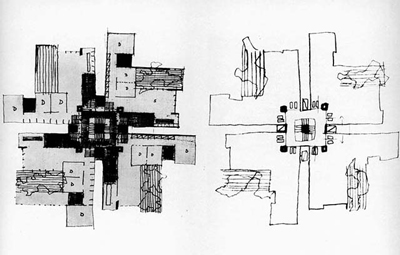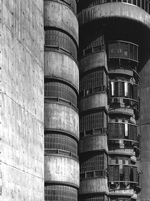You are in: Home page > Magazine Archive > Torres Blancas

Torres Blancas. Initial sketches
Abstract
In 1960s Madrid, the Navarrese architect Sáenz de Oíza tried constructing a residential tower in reinforced concrete. The happy result of a partnership with an entrepreneur patron, Juan Huarte, the building is split into L-shaped dwellings and duplexes, rooms for offices and services, as well as communal spaces, such as a swimming pool and a restaurant on the roof terrace, to exemplify a model of a small, self-sufficient town.
In 1961, Francisco Javier Sáenz de Oíza was commissioned by Juan Huarte, a well-known industrialist, and already patron of a group of important artists including Oteiza, Palazuelo, Cela, and Chillida, to design the “Torres Blancas”. Even though Oíza had won the Premio Nacional de Arquitectura back in 1954 with his project for a “Chapel on the Road to Santiago”, most of his professional activities in those years involved residential buildings, from council estates to detached houses.
Sáenz de Oíza came from Navarra, like Juan Huarte, and unquestionably it was his strong personality, his erudition and his professional standing that caught the entrepreneur’s attention.
The building of the Torres Blancas was born as an operation of institutional prestige, to probe a quite precise theme: a proposed “ideal tower”. And the patron knew that Oíza possessed the ability to make his intentions concrete.
Stacking apartments vertically was an extremely unusual idea in Spain at that time, which underlines the singularity of the notion. The basic idea was to create garden-apartments one on top of another, arranged not as a simple sum, but designed to compose a complex order. This proposal underlined the possibility of making the modern idea of the “house in nature” compatible with the logic of the tower, in other words with a sufficiently dense urban structure featuring communal services.
The initial intention in designing Torres Blancas was, as Oíza explained, to offer a very free structural knit on platforms of different heights kitted out with the necessary utilities, as if they were “lots” on which clients could build their own home in complete freedom. The themes of “flexibility” in the use of the house and the “participation” of the use in its layout, which was being debated at that moment in certain theoretical circles, formed part of his intellectual interests. Oíza himself described the circumstances in which this process came about:
“At a given moment, Huarte, during his trip to Paris, sent me a telegram that turned out to be revolutionary. It stated that the real freedom for a man who wants a house was to find a good product and make it his own. Being able to identify with the design. Starting out from this, two conditions arise to develop the design: a certain freedom in varying the plan, and a structure with concrete partitions.”1
In the citation it is possible to appreciate the value of the relationship between Juan Huarte and Oíza during the Torres Blancas project, but also the material condition it was to be built in and the structural importance that concrete would acquire in the tower. As regards this aspect he counted on the collaboration of the engineers Carlos Fernández Casado and Javier Manterola.
During his lessons as professor at the Faculty of Architecture, Oíza would occasionally refer to the Torres Blancas project. Regarding the structure of a tower he spoke of two extreme positions: the “all inside” and the “all outside”. As we can see from the first sketches, he initially thought of concentrating the whole structure inside, joined to the communication nuclei and the service elements. The apartments would be arranged around this centre, arranged as “Ls” surrounding a private garden in turn shaped like a swastika, to obtain the greatest seclusion possible. The reference to the tree, with a trunk that branches leave from, confirms Oíza’s interest in organic structures at that time. However, it was unquestionably necessary to improve wind resistance and to this end, it would be opportune to shift the structural elements to the perimeter.
The vertical organization of the tower could not be achieved simply by piling up dwellings, which is why in the study models several attempts were made to vary the arrangement of the units. By shifting the structural shields to the outside, Oíza turned to the metaphor of the tree, in which the bark encircling the trunk produces greater inertia to lateral bends and also protects the internal conduits that feed the organism from the roots up; the lower floors of the car parks, up to the residential spaces that open outwards like branches, and stretching on towards the sky to house the tower’s communal space.
The design phase lasted over three years, with different trials, sketches and models that regularly ended up as technical drawings. Many drawings exist, some of which have been published, the outcome of a work process that merits thorough study. Oíza said that, at a certain point, drawings plans on top of a triangular pattern, he “found himself” with the same solution as the Price Tower that Wright had built a few years earlier.
Then again, the functional programme which the architect had always discussed with the owners, envisaged dwellings of different types and sizes, from normal apartments to duplex solutions, as well as spaces for offices, commerce, services, all-purpose rooms, and leisure facilities, such as communal gardens and a swimming pool.
This programme supported the idea of making the values of nature compatible with the urban context.
The tower was to be conceived as a small, self-sufficient town.
The house embraced the garden typifying its seclusion in different ways, to avoid the intersection of sight lines between apartments. Sunlight was an important issue for Oíza, and arranging the apartments as a swastika would have compromised the orientation of one of the dwellings. This situation was avoided by altering the rigidity of the initial scheme and a as a result the apartment previously oriented N/S was rotated to face NE/SE. The significance of this change became formalized in a large sketch, drawn using bright colours, to mean that from that moment the definitive solution would start to be designed.
The precise placing of the towers was not decided at the beginning: drawings exist that show it built in white concrete inside a generic green space. In the end the sponsor decided to make use of land he owned in Madrid, near the motorway to the airport. Town planning regulations obliged the creation of a single building. It was not possible to use white concrete because of economic issues, and the name, Torres Blancas (“White Towers”), was kept only as a reference to the initial commission and the design process.
It is not easy to understand the layout of each floor. There are three types of apartment. The most frequent one, which is arranged in four units per floor, is the one Oíza calls “normal” with four bedrooms, one with en-suite. The other is the duplex, which practically doubles the former. Lastly, there are the smallest units, eight per floor, which in turn are divided into two types. Except for the latter, all the units have two entrances, the main one at the level of the house and a service one upstairs or downstairs. This introduces a new variety. All of this “urban” diversity takes place in a vertical development, from the basement level to the top storeys.
Access to the building is by descending from street level. The tower was required to show its own “weight” by sinking into the soil. Oíza laid much emphasis on the layout of the entrances, the passing places that these systems demand, and praised the principles of Team 10 (in 1962 he attended the Royaumont Congress). In this way, each of the ways to enter the building, also from the underground car park, would have sufficient dignity. The upper storeys were to accommodate offices and communal spaces, would be air-conditioned and also outdoor, like the swimming pool and the gardens. With the inclusion of a restaurant from which it would be possible to send ready-made dishes to the kitchens of the apartments using service elevators.
Building the tower in those years, from 1964 to the end of the decade, constituted a real challenge from many points of view. The technical ability of the well-known engineers who intervened was severely tested, and as well as static calculations, models were made of the structure to guarantee it would work. For Oíza any hitch was a chance to experiment, from the utility systems and materials, to the simplest functional element. A surprising solution could be found to any kind of problem. He insisted on dealing with even the most modest of details, which he would design throughout all the construction phases. For example, the kitchen windows, which, by opening inwards, allowed a view of the street also from the work floor, were made in teak and could be taken apart to be cleaned in the sink.
Sáenz de Oíza lived for a long time in the Torres Blancas in a duplex on the fifth floor. A much lived-in house, integrated into the terrace garden, where inside and outside formed complementary places. He never tired of repeating that buildings should expand at the edges, like bones. With regard to this expansive value of the limit, he said:
“The threshold is the space that allows the interior to relate to the exterior; therefore it is its existence. It comes from the private life, however it also has a public projection. Thus the threshold is the centre of the world: those village women on the threshold of farmsteads are at the centre of the world. Like the bird that sits on the edge of its nest: in the centre it enjoys its interior life with its chicks, however it has to leave to go hunting and when it perches on the edge, looking inwards and outwards, it is at the centre of its world.
This is very important for architecture, and consequently architecture is much more important the broader its edge, its threshold, is.“
We really can see the Torres Blancas as a place made up of wide edges of air and broad thresholds.
Notes
1 Cited in issues 32-33 of the magazine «El Croquis» Monograph dedicated to Sáenz de Oíza. El Escorial, February-April 1988.
José Manuel López-Peláez (Madrid 1945). Full professor of Architectural Design at the Superior Technical School of Architecture of Madrid. Author of numerous critiques and the books “L’Arquitectura de Gunnar Asplund” and “Maestros Cercanos”. Founder of the firm Frechilla & López-Peláez, whose work has won several prizes and has been widely published















